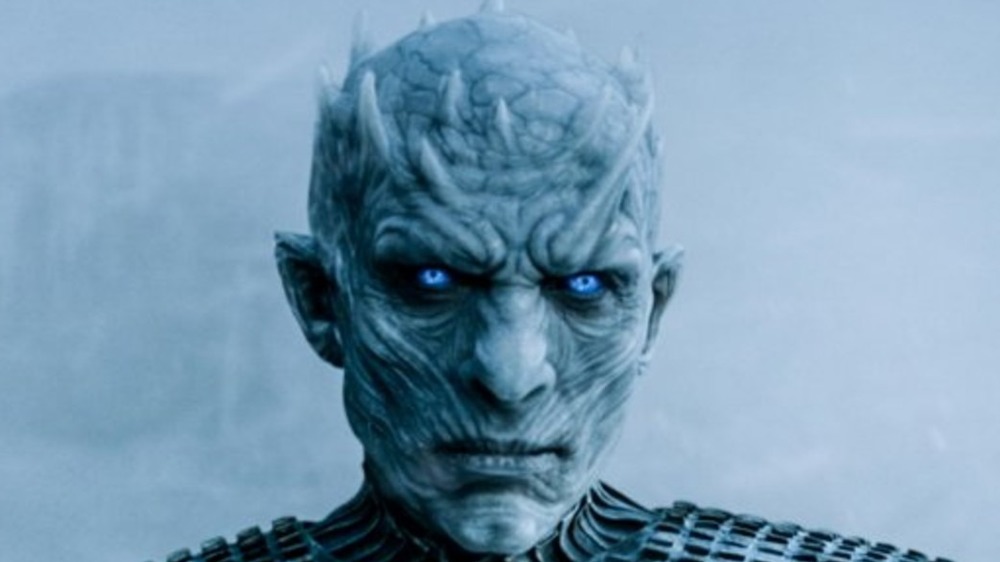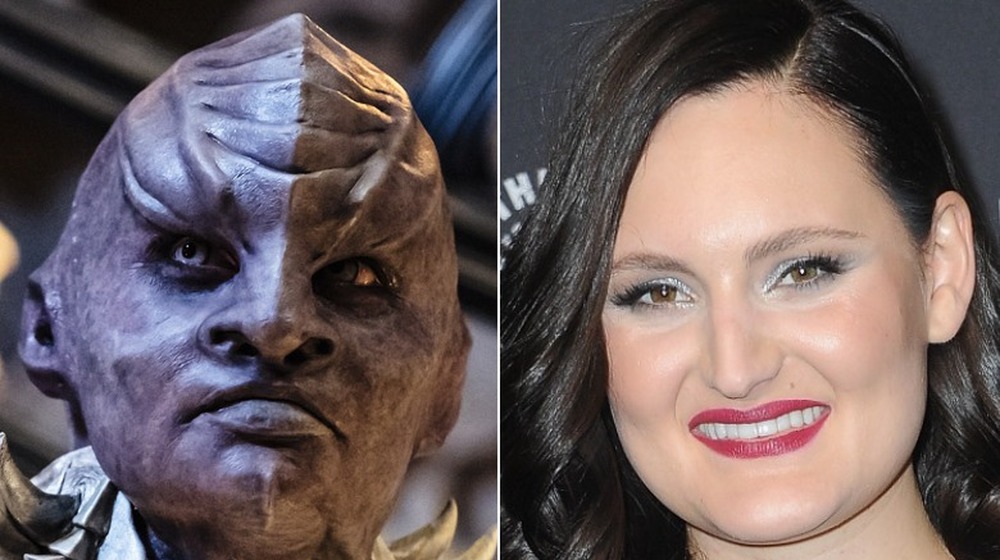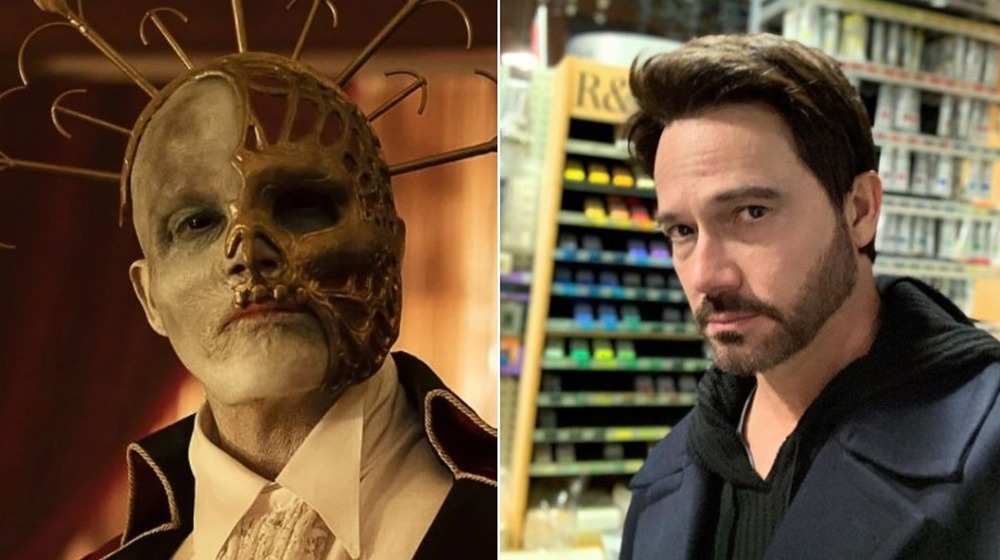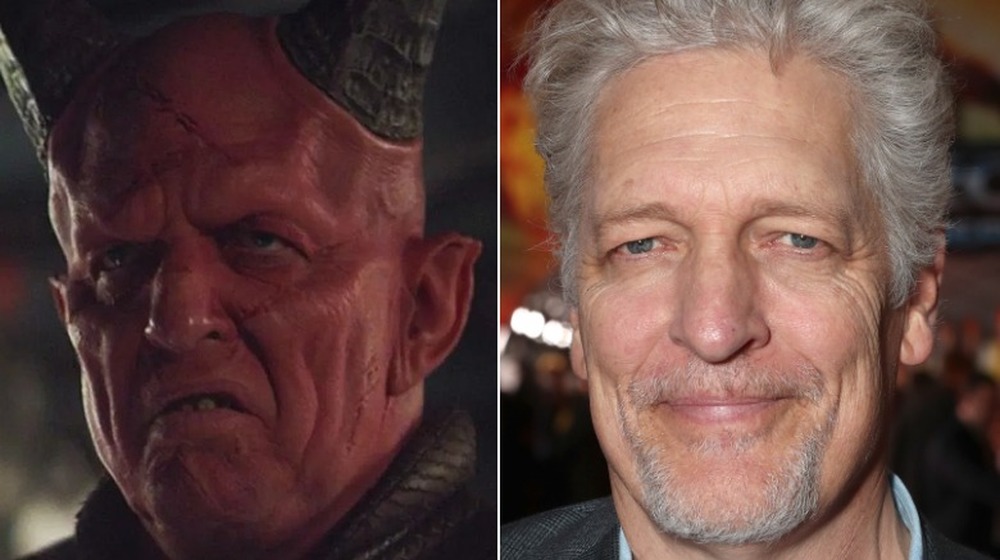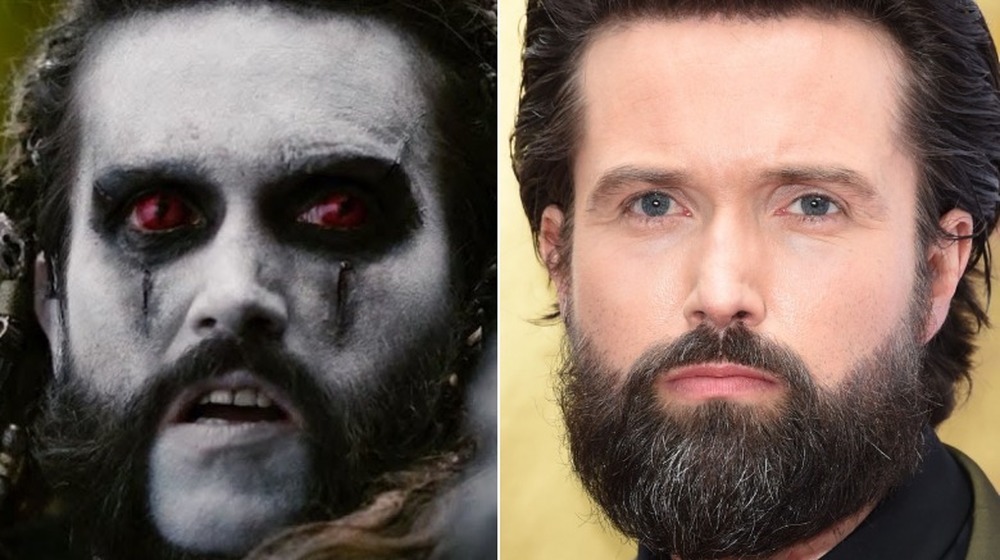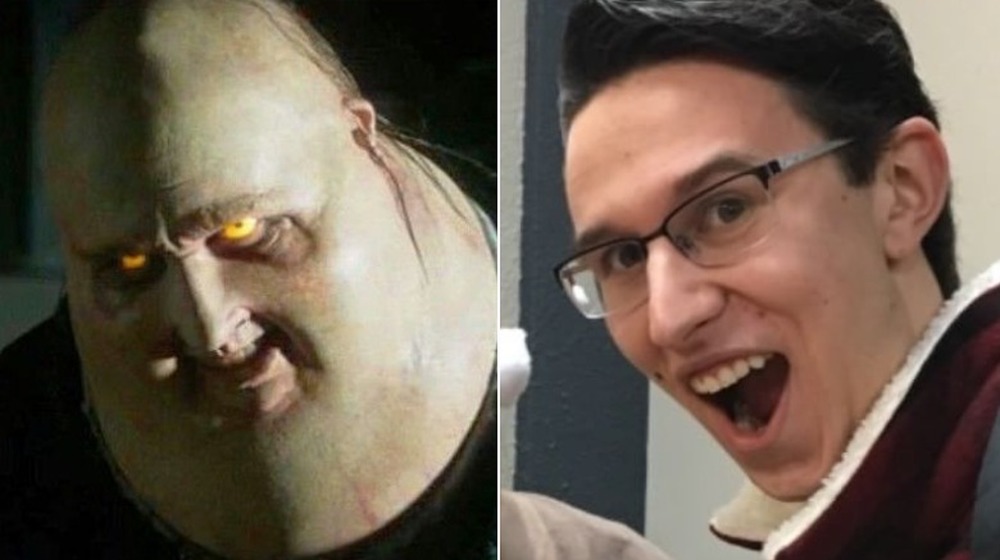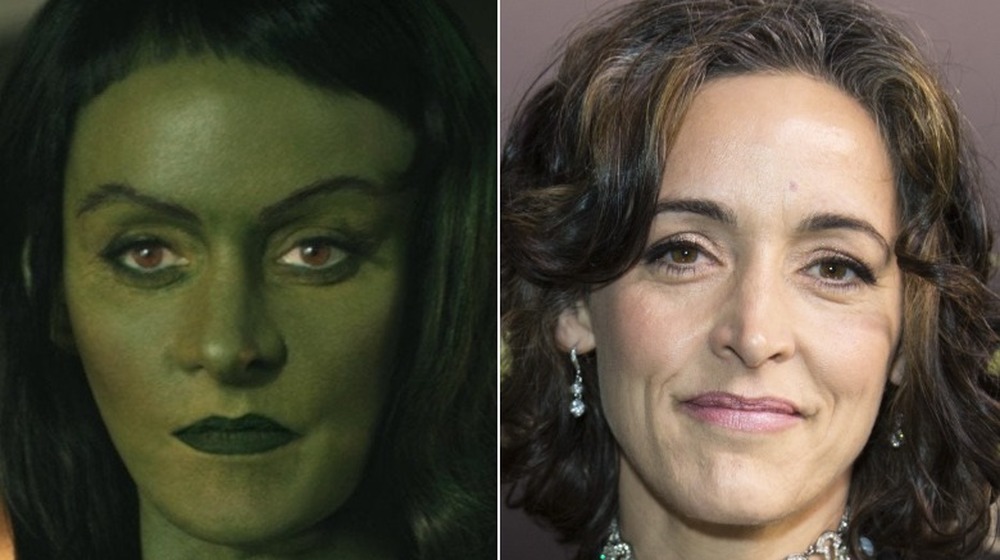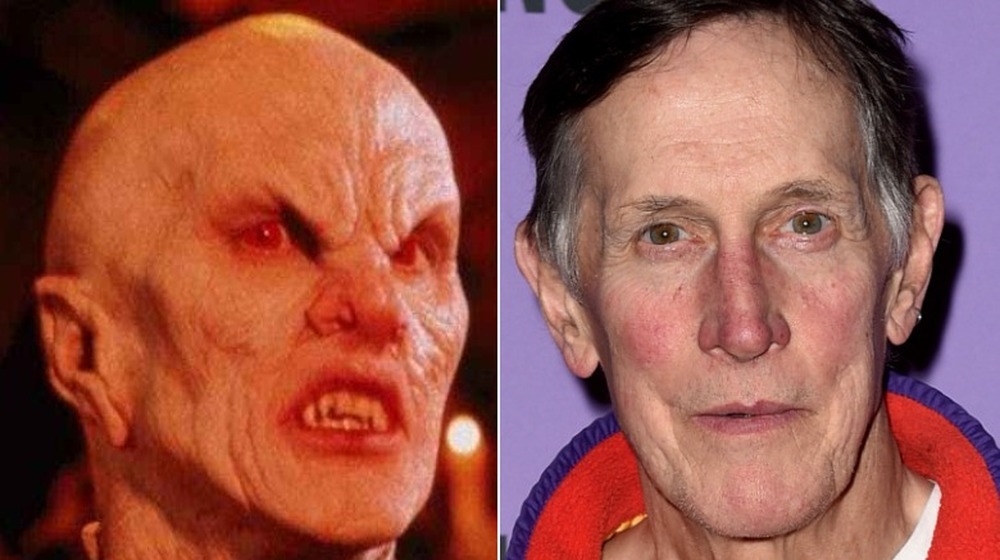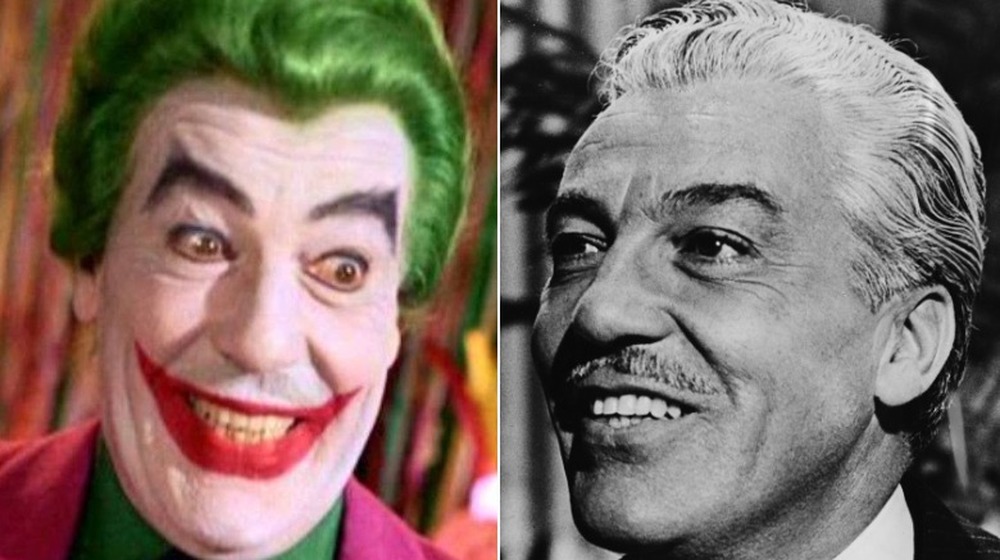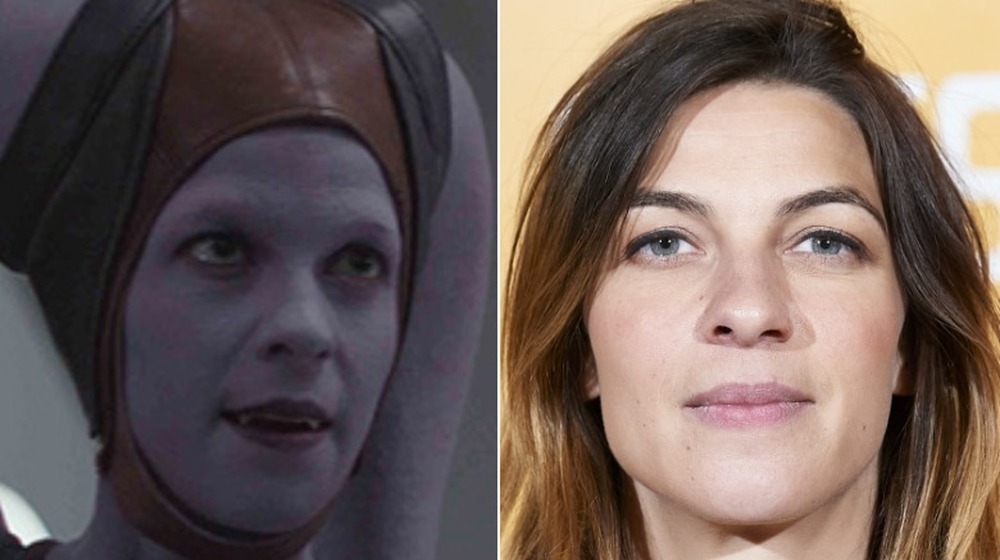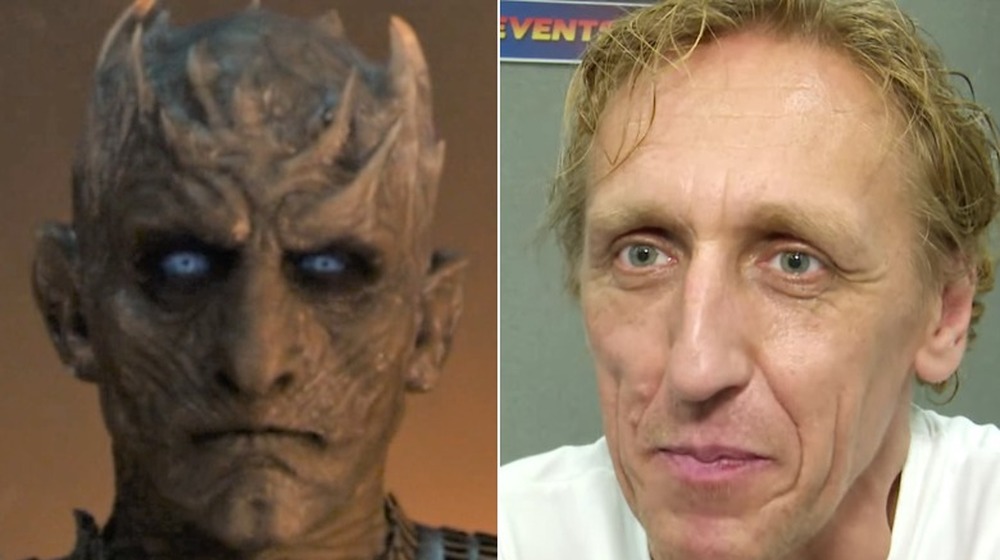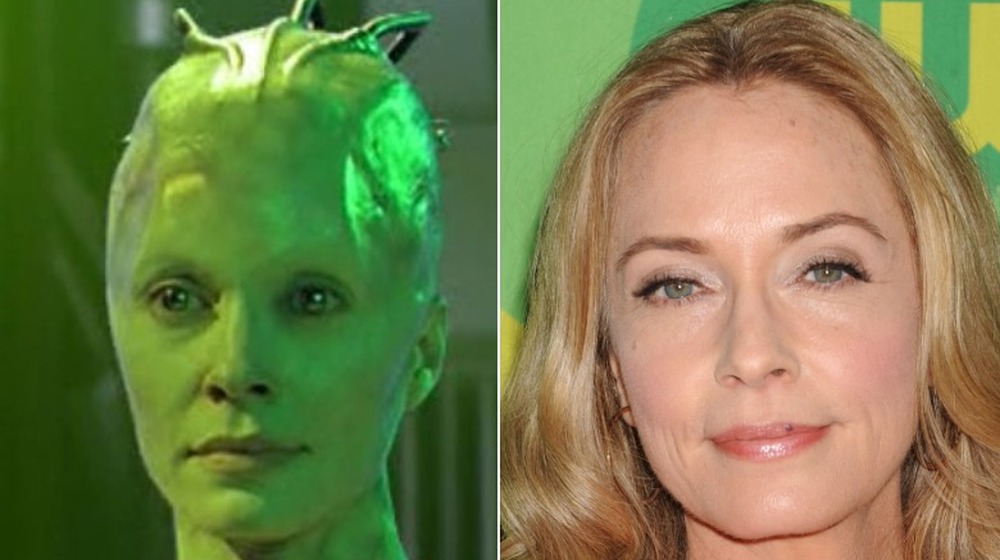What These TV Villains Look Like Without Makeup
They're invaders, sadists, thieves, and parasites. They're undead warriors, cackling madmen, and intergalactic bounty hunters. They're the bad guys, and sometimes, in order to make sure they look as intimidating as possible, they have to work under a mountain of makeup. What's it like for an actor to emote from under layers of prosthetics? Is it confining? Empowering? Do they dread the long morning hours in the makeup chair, or do they focus on how being able to literally see someone else in the mirror can help them become someone else on camera?
Moreover, what's it like for us to see those actors when all the layers of make-believe are peeled away? Sure, we know the actors playing aliens on shows like Star Trek and The Mandalorian are real people with real lives. But it's one thing to know that, and another to spend hours getting to know someone as a green-skinned alien warlord, only to be confronted on the actor's Instagram by a woman who looks as normal as any of us.
From science fiction hits, fantasy epics, superhero dramas and more, here are examples of what these TV villains look like without all that makeup.
As L'Rell, Mary Chieffo had help finding her happy place
For Star Trek: Discovery, the visual design of the beloved Klingon warrior race was revamped, and Mary Chieffo was one of the first actors to assume the new look as the recurring character L'Rell. For most of the first season, L'Rell is a devoted follower to T'Kuvma, a Klingon more than happy to make war on the United Federation of Planets in order to unite his own people.
In 2018, Chieffo told IndieWire that L'Rell is her first role involving heavy prosthetics. Wearing them makes simple but essential tasks like going to the bathroom and eating problematic, but she's stayed focused on how they help her inhabit her role. As she detailed, "On the first camera test day, I looked in the mirror, and I was not myself." The prosthetics also force her to explore her movement: "You really have to rely on movement so much, because you don't get quite as much nuance in the face."
Chieffo also said she's had a great deal of support from Doug Jones who plays the Kelpien Starfleet officer Saru on Discovery. Jones has more experience with prosthetics than most, having famously played creature characters in movies like Pan's Labyrinth and The Shape of Water. Speaking of the long hours in the makeup chair, Jones said he gave Chieffo the same advice he gives everyone: "Sit still, do as you're told, and find your happy place."
Roger Floyd took great pains to play Red Jack
Roger Floyd only appears in one episode of Doom Patrol, but that's all it takes for him to become one of the most memorable villains of the series. Literally feeding on pain and suffering, Red Jack is a powerful being from another dimension who brings new meaning to the word "sadism." In "Pain Patrol," Red Jack invites the team to his palace because he believes their leader Niles, AKA the Chief (Timothy Dalton), to be a fellow pain connoisseur and wants him as a protégé. When Niles refuses, things turn ugly. Well ... uglier.
While his look is heavily influenced by the Red Jack of the comics, some interesting and smart changes were made to his appearance. For one, while the front of his headpiece appears smooth with eyeholes in the comics, Floyd's headpiece includes an ornate, skull-like design. For another, the headpiece only covers half his face, revealing a grey and shriveled visage.
Floyd isn't the only actor in his family, or even the only Roger. His son, Roger Dale Floyd, has made some memorable screen appearances of his own, including playing the young Danny in 2019's Doctor Sleep. When he asked his father to record an impersonation of Patrick from SpongeBob SquarePants while in the Red Jack makeup, Floyd complied, and thankfully threw it up on his Facebook page for everyone to enjoy.
For The Mandalorian, Clancy Brown wears more makeup than usual
Clancy Brown gives great bad guy. He lent his voice to Surtur in 2017's Thor: Ragnarok, made prisoners miserable as Captain Hadley in 1994's The Shawshank Redemption, and played the nigh-unbeatable Kurgan in 1986's Highlander.
Compared to those villains, Brown's role on the first season of The Mandalorian is less verbal, but no less intimidating. Brown shows up in "Chapter 6: The Prisoner" as a red-skinned, horn-headed Devaronian named Burg. As part of the team infiltrating a New Republic prison ship to spring one of its involuntary passengers, Burg proves to be one of Mando's toughest fights. In spite of being set on fire and having two separate pairs of blast doors closed on him, Burg survives the episode, albeit as a prisoner.
Even though he's practically unkillable in the episode, it seems unlikely Burg will return. When asked about reprising the role by The People's Movies in October 2020, Brown answered, "Nobody has talked to me so probably not." But you never know: In November 2020 Brown posted a selfie holding a Grogu collectible, along with a thank you to Sideshow Collectibles for "sending #TheChild straight to #Burg Wonder what #TheMandalorian will do now."
Plus, it isn't like Brown and The Mandalorian executive producer Dave Filoni are strangers. Brown's used his deep voice numerous times on Filoni's animated projects, including Star Wars Rebels and The Clone Wars.
Playing Lobo was liberating for Emmett J. Scanlan
Krypton made a bit of superhero history in its second season: It brought fans the first live-action appearance of Lobo, a ridiculously powerful alien bounty hunter who gained popularity as an antihero in the early '90s. While the character got a major redesign in the wake of DC's New 52 reboot, Krypton chose to go with the classic look that, as many websites noted, looks a lot like Rob Zombie.
To play the "Main Man," Krypton chose the Irish actor Emmett J. Scanlan, and to hear Scanlan talk about it, it was a liberating experience. "With Lobo ... the only limitations you have is your imagination and with that you can go anywhere," Scanlan told Geek Vibes Nation in May 2019. "Once I had the costume make up, hair, and eyes in, I danced. I let it organically go where it wanted to go ... I didn't try to control this beast, I just rode it." That same month, Scanlan told ComicBook.com that the role of Lobo is "the most fun" he's had with a character.
Sadly, the fun wasn't fated to last. In spite of being impressed enough with Scanlan's Lobo to greenlight a spin-off series for the Main Man, fans learned in August 2019 that not only had Krypton been canceled, but that plans for Lobo were scrapped.
Legion's Devil was discovered accidentally
While the villain Amal Farouk is later played by Navid Negahban on FX's Legion, the first main physical representation we get of his influence is the Devil with Yellow Eyes. The pale creature is played by Quinton Boisclair, a man whose casting was a wonderful stroke of luck.
In a 2017 interview with Deadline, Legion prosthetics designer Sarah Pickersgill called the discovery of Boisclair a "fluke." She said an unnamed crew member found Boisclair working at either "a comic book store, or a toy store." Boisclair stood out because of his six-foot-ten height and slender build. Pickersgill pointed out that this is a desired physique for creature work, because "we're always building onto somebody, so to start off with a smaller frame always works for us."
But once Boisclair signed on, it turned out his physique wasn't all he had to offer. Boisclair was already a big comics fan, so he wound up educating the makeup team about who they were turning him into. "Honestly, we didn't really know the background on the comic book, so he would fill us in while we were doing his makeup," Pickersgill told Deadline. She added that she wasn't sure if what Boisclair told them impacted how they did makeup, but that "it was interesting to learn, as we went, more about the character."
Janet Kidder would play Osyraa for 32 centuries if she could
The ruthless Osyraa makes a major mark on Star Trek: Discovery's third season. Osyraa is the head of the Emerald Chain, a conglomerate of mercantile exchanges banding together after an intergalactic cataclysm known as the Burn. In order to get what she wants, Osyraa enslaves, murders, and holds entire worlds hostage with the threat of famine — or worse. With green skin and a steely glare, Osyraa is played by Janet Kidder, who, as it turns out, absolutely loves getting to be this bad.
"I could happily play Osyraa for as long as they let me," Kidder told Trek Report in early 2021. She called the chance to play a villain "an absolute gem of an opportunity," adding that being able "to ignite the darkest kept sides of ourselves is an incredibly cathartic experience."
Osyraa is an Orion, one of the very first alien races introduced in Star Trek: The Original Series. While Orions haven't popped up as often as Klingons and Vulcans, they're being brought to the forefront in Trek shows of the 2020s. Along with Kidder's memorable performance as Osyraa, the animated series Star Trek: Lower Decks includes the geeky Ensign D'Vana Tendi, played by Noël Wells.
Incidentally, if you're thinking the only makeup Kidder has to deal with is Osyraa's green body paint, think again. In 2020, she told SyFy Wire her costume includes a "full prosthetic head" that "takes about four hours to put on."
Mark Metcalf helped create the Master in more ways than one
You may remember Mark Metcalf as fraternity bully Doug Neidermeyer in National Lampoon's Animal House, wealthy Aguila Beckersted in One Crazy Summer, or as the recurring Seinfeld character who insists on being referred to as "Maestro." But to Buffy the Vampire Slayer fans, he will always be the Master, the longest-living vampire known to have existed. His bloodline is the source of the series' most infamous vampire villains, including Darla, Angel, Spike, and Drusilla.
Visually, one of the things that makes the Master unique is that he only ever appears in his vampiric form, unlike most vampires on Buffy, who switch back and forth between their human features and their demonic visages. The narrative explanation for this is that the Master's lived long enough to shed the "curse" of his human appearance.
Another difference between the Master and the other Buffy vampires is thanks to Metcalf himself. In a 2015 interview on the Whedonverse podcast, Metcalf said the original designs for the Master included "long black hair" and an "angular" look. The actor explained that he wanted to bring more of the "history and tradition" of vampires into his design — specifically, he wanted a look based off Max Schreck's Count Orlok in the 1922 silent classic Nosferatu. Buffy creator Joss Whedon agreed, and the rest is big bad history.
The Joker and Cesar Romero didn't look as different as you might think
Long before Joaquin Phoenix, Jared Leto, Heath Ledger, or Jack Nicholson came along, Cesar Romero was the face of the Joker. To an earlier generation, Romero was best known as a dashing heartbreaker in musicals and romantic comedies, and he would continue to appear on TV and in films until the '90s. Still, his recurring role in the '60s Batman show and 1966's Batman: The Movie forever married his name to that of Gotham City's Clown Prince of Crime.
Given Batman's campy tone and family-friendly content, Romero's portrayal of the Joker goes nowhere near the dark places his successors have explored. This is, of course, to be expected. In a show that includes comic book sound effects within its fights — or, as some fans call them, "Bat-Fight Words" — and a young sidekick proclaiming puns every episode, you can hardly expect a villain who hangs out in strip clubs like Leto in Suicide Squad, or murders stock brokers on subways like Phoenix in Joker.
Visually speaking, perhaps the thing that distinguishes Romero the most from later Jokers is how relatively unchanged he looked in and out of makeup. This is largely because of one famous detail: Romero refused to shave his mustache for the role, and no amount of white makeup ever succeeded in hiding it.
Natalia Tena's inner geek was overjoyed to play Xi'an
By 2019, Natalia Tena had made a place for herself in the hearts and minds of nerds everywhere. She'd already appeared in three Harry Potter films as the witch Nymphadora Tonks, on HBO's Game of Thrones as the wildling woman Osha, and in the "White Christmas" episode of Black Mirror. That wasn't good enough for the actress, apparently, because she makes a memorable appearance in the first season of The Mandalorian as the Twi'lek criminal Xi'an.
Xi'an appears in "Chapter 6: The Prisoner" as one of the crooks who recruits Mando to help free her brother Qin (Ismael Cruz Cordova). Tena confirmed her part in The Mandalorian on Twitter in August 2019, retweeting the series' trailer and writing, "Can you spot my purple alien face? So honoured to have been part of this banging series, my inner geek is doing backflips with bells on."
While Tena has only appeared once in The Mandalorian so far, her character is unique in the series in that she's the only person to imply she's been intimate with Mando. Though, in fairness, Xi'an doesn't come off as a particularly mentally stable character, so she might not be a reliable reporter.
Vladimir Furdik isn't sure how he was picked to play the Night King
You may have assumed Game of Thrones' Night King to be a CGI creation, but Slovak actor and stuntman Vladimir Furdik would disagree. Furdik, who played the baddie in the last three seasons of the show, spoke to Vulture shortly after his final appearance aired, and revealed how long it took to transform into the frozen villain: "Six hours makeup, 30 minutes costume." One way he spent his time in the chair was doing yoga. "I cannot move. I sit straight," Furdik explained. "It's an exercise that I do in my apartment, then I have a very nice yoga exercise every morning on the chair."
Furdik took the role of the Night King over from Richard Brake, who played the leader of the White Walkers in Game of Thrones' fourth and fifth seasons. Known mostly for his stunt work (including plenty of stunts on GoT) Furdik told EW in 2019 that he wasn't sure why he was tapped for the part, but that it seems likely he'd impressed someone in an earlier attempt to kill Kit Harrington's Jon Snow. "When we did season five, I was the White Walker who fought Jon Snow [in 'Hardhome']," Furdick recalled. "The first time Jon Snow killed a White Walker, that was me. After that, [showrunners David Benioff and D.B. Weiss] asked if I'd play the Night King for seasons six through eight. I never asked why."
Susanna Thompson got a second chance to lead the Borg
Susanna Thompson's played a number of different Star Trek characters over the years — she was even one-half of the franchise's first same sex kiss on Star Trek: Deep Space Nine. But one Trek role she was probably more than a little surprised to have landed was one she'd already lost.
In an interview included in the Star Trek: Voyager season five home release special features, Thompson explained she had auditioned for the role of the Borg Queen in 1996's Star Trek: First Contact, but that the role went instead to Alice Krige. Thompson wasn't sure why Krige wasn't able to initially reprise the role for Star Trek: Voyager (though Krige does return for Voyager's series finale), but regardless, Thompson got the opportunity to take Krige's place in season five's "Dark Frontier," and in the two-parter "Unimatrix Zero," bridging the sixth and seventh seasons.
Thompson said dealing with the makeup and costume almost made her quit after the first day of shooting on Voyager. She singled out the contacts she had to wear, which reportedly had metal in them. "I cried myself to sleep," Thompson recalled. "I said I didn't care how much money they paid me, I wouldn't do it again." Thankfully, she didn't stick to that promise, and instead got the crew to agree to pace the shooting schedule so she could have more time without the troublesome contacts in.
